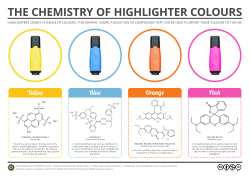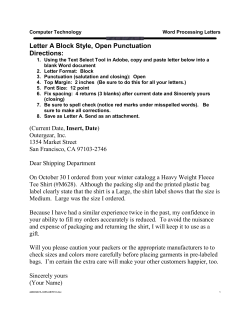
TIE DYE CHEMISTRY INTRODUCTION
TIE DYE CHEMISTRY LAB MSC 1 From Flinn CHEM FAX Publication #10075 INTRODUCTION The art of dying clothing fibers probably originated in India or China no later than 2500 BC. Most natural dyes came from parts of plants; such as the bark, berries, flowers, leaves, and roots. Because these dyes did not have a strong attraction for the fibers being dyed, a process known as mordanting was used to improve colorfastness. To react with acidic dyes, fibers were treated with basic or metallic mordants that might include solutions of aluminum, copper, iron, or chromium salts. Compounds formed by the dye and the mordant, called lakes, prevented the colors from washing out and made the color longer lasting. Such natural dyes became less and less important as synthetic dyes that produced brighter colors were developed. Today, logwood black is the only natural dye widely used. In 1856, William Henry Perkin began the synthetic organic chemical industry by accidentally discovering the purple dye, mauveine, when he tried to produce quinine from aniline. The synthetic dyes were known as coal tar dyes because the six-membered ring structures of carbon atoms were all derived from coal tar. Congo Red was the first dye discovered with so great an affinity for cellulose that a mordant was not required. About 100 years after Perkin’s first discovery, fiber-reactive dyes capable of forming covalent linkages with the fiber were discovered. Fiber-reactive dyes are wash-fast. During dyeing, dye molecules must diffuse from the aqueous solution into the fibers. Fibers such as cotton absorb water readily and are said to be hydrophilic, while fibers such as polyester absorb water with difficulty and are described as hydrophobic. Dyeability is influenced if a fiber can somehow carry an ionic charge and better interact with the oppositely charged colored ions. To dye cellulose, a reactive dye must combine with the hydroxyl groups in the fiber. Tie dying is one of the oldest methods of printing designs on fabrics. Typically, parts of the fabric are bunched together in a design and knotted or tied together with string. Tied sections are protected from absorbing the dye and patterns are created. Westminster College SIM MSC1-1 Tie Dye Chemistry PURPOSE The purpose of this activity is to use the process of tie dying to illustrate a variety chemical concepts, including equilibrium, kinetics, and pH. MATERIALS 100% cotton T-shirts, prepared for dyeing Plastic bucket Zipper-sealed bags or small trash bags Rubber bands, size 33 (3½″L x ⅛″W) Beral-type pipets, 15 mL bulb capacity 2 L sodium carbonate activator solution Plastic drop cloth 1000 mL beakers Disposable plastic gloves Reactive dye solutions Newspaper SAFETY • Always wear safety glasses in the lab. • Wear disposable plastic gloves and chemical-resistant aprons. Old clothes and shoes should also be worn because once the reactive dye makes contact with clothes, it will not wash out. • Use filled pipets appropriately. Don’t get sloppy or squirt others with the dye solutions. • Use caution handling the sodium carbonate solution, it is very basic. Wear plastic gloves when placing the T-shirt in the solution and when the shirt is wrung out at the end of the activation period. DISPOSAL: Check with you teacher for disposal instructions. PROCEDURE 1. Wear gloves throughout the procedure. 2. Fill the plastic bucket with 2 liters of sodium carbonate activator solution. 3. Soak the T-shirts in the sodium carbonate activator solution for a minimum of 20 minutes. (Soaking for 2 hours maximizes the number of possible bonding sites.) The ionization of cellulose increases with the increasing alkalinity of the solution and above pH 8 there is an adequate number of ionized hydroxyl groups in the fiber for most dyeing purposes. Westminster College SIM MSC1-2 Tie Dye Chemistry 4. After the T-shirt has soaked, wring the T-shirt out over the plastic bucket. Add more sodium carbonate solution to the bucket as needed. CAUTION: The sodium carbonate activator solution is very basic, so be sure to wear gloves when placing the shirts in the solution and when wringing out the shirts at the end of the activation period. 5. Shirts are now ready to fold. Please refer to Tie-Dying Instructions, pages 4 and 5, for directions for creating various designs. HINT: Folding should be done in an area separate from the dyeing area to prevent shirts from picking up dye by mistake. 6. Dyeing can be done on oven racks placed over sinks or on racks placed over enough newspaper to absorb excess dye. 7. After a shirt is placed on a clean rack, dyes can be applied using jumbo beral-type pipets. Apply the dye to one side of the shirt by slowly squirting the reactive dye solution onto each section of the shirt. Once you are done dyeing one side of the shirt, turn the shirt over and repeat the dyeing process. Allow shirts to drain for 15 minutes. 8. Place the shirt in a zipper-sealed bag or small trash bag and close it to keep the shirt moist. Be patient. Keep the shirt in the bag for 24 hours to allow the dyes to react completely. 9. At home, rinse the shirt in warm water (75-90ºF) in order to remove the unreacted dye and the sodium carbonate activator. Change the water and continue to rinse. Repeat until the water remains clear and the shirt does not feel slippery. 10. Wash as many as 10 shirts at a time in a hot water cycle with 2 tablespoons of a prewash such as Joy® or Dawn® dish soap. Dry the shirts on the hottest dryer setting. The shirts are now safe to wash with other clothing using normal detergents. The reactive center on the dyes is a dichlorotriazinyl group, so do not use bleaches on the shirts. 11. Now be creative! Dye other types of clothing and try other patterns for folding. You can even use this lab as a fundraiser for the science club at your school. Westminster College SIM MSC1-3 Tie Dye Chemistry Westminster College SIM MSC1-4 Tie Dye Chemistry Westminster College SIM MSC1-5 Tie Dye Chemistry ANSWER SHEET Name _____________________________ Name ______________________________ Period ________ Class ________________ Date _________ TIE DYE CHEMISRTY 1. If you dyed a rainbow spiral on a shirt and then soaked it in a black dye bath, the result would be a black shirt with a rainbow spiral pattern. Why doesn’t the entire shirt dye black? 2. Why do you have to pre-wash the items being dyed? 3. Why is 100% cotton the best type of cloth to use with fiber reactive dyes? 4. What are some advantages of fiber reactive dyes? 5. What is the purpose of soaking the shirts in sodium carbonate? Westminster College SIM MSC1-6
© Copyright 2025





















